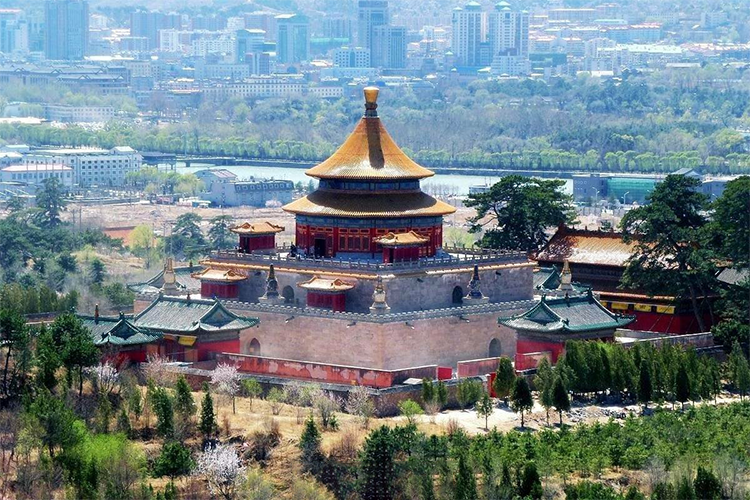Explore Chengde’s Outer Eight Temples — UNESCO World Heritage Travel Guide
Introduction
At dawn, among the Danxia-formed hills around Chengde, gilded copper roofs catch the first light and the low cadence of monastic horns drifts from red-and-white palace complexes — it looks like Tibet, yet it is not. The Outer Eight Temples, a Qing‑era imperial ensemble of Tibetan Buddhist architecture, pairs Han-style eaves with plateau-style golden roofs to tell a 300‑year-old story of cultural coexistence. Walk the weathered stone steps, spin prayer wheels brushed by your fingertips, and you can almost hear Kangxi, Qianlong, and Mongolian-Tibetan lamas echoing through time.
1. World-heritage-level political wisdom
“One temple is worth more than ten thousand soldiers,” Qianlong famously said, capturing the Outer Eight Temples’ strategic significance. Built between 1713 and 1780, this is the best-preserved imperial group of Tibetan Buddhist temples in China. Seven major temples remain (originally eight; Puren Temple was destroyed), including Puning Temple and Putuo Zongcheng Temple. These were not merely religious sites but a concrete expression of the Qing dynasty’s policy of conciliating frontier peoples — reproducing sacred sites from Tibet and Mongolia (like the Potala Palace and Tashilhunpo Monastery) so distant leaders such as the Dalai Lama, Panchen Lama, and Mongol princes could find spiritual belonging here. In 1994 UNESCO inscribed the Outer Eight Temples together with the Mountain Resort as a World Heritage Site, praising it as a pinnacle of multi‑ethnic architectural fusion.
2. Architectural marvels: a Han‑Tibetan visual feast
Stand before the Grand Hall of Puning Temple and look up at the 22.28‑meter gilded wooden Avalokitesvara (Thousand‑Hand Guanyin) and many visitors are left speechless — you must look up to see its compassionate face. Forty‑two arms radiate outward, each palm intricately carved with an eye of wisdom. Climb onto Putuo Zongcheng Temple’s crimson platform and you feel transported to Lhasa: the 60‑meter Tibetan‑style main structure echoes the Potala Palace, with trapezoidal blind windows on white walls and Han glazed archways blending in surprisingly harmonious ways. Its golden roof blazes like flame in sunlight.
Cultural codes hidden in details:
– Gold tiled roofs: gilded fish-scale copper tiles that reflect seven shades in sunlight, symbolizing boundless Dharma
– Sumeru thrones: white Han marble bases carved with Tibetan makara beasts, embodying the idea “Tibetan peaks above, Han base below” in governance
– Glazed archways: Qianlong’s calligraphy “Pumen Yingxian” appears in Manchu, Chinese, Mongolian, and Tibetan scripts
3. Immersive pilgrimage experience guide
Religious activity observation
At 6:30 a.m. the morning chants at Puning Temple sweep through the Main Hall with the first rays. Visitors can quietly observe the morning rites as saffron-robed monks recite the Great Compassion Mantra in deep throat tones while bronze horns vibrate the beams. On the 15th day of the lunar fourth month (Buddha’s Birthday), the temple holds a dramatic “Cham” masked dance, portraying exorcisms and spiritual triumph.
Etiquette for participation
– Spin prayer wheels clockwise; avoid touching the mantras directly with bare fingertips out of respect
– Hold incense with your left hand (left is considered clean in local Buddhist practice); three sticks symbolize “precepts, concentration, and wisdom”
– Before the three‑dimensional mandala at Xuguang Pavilion, follow local Tibetans in scattering barley as a blessing

4. Deep‑dive time capsule
Must‑see halls
1. Puning Temple’s Grand Hall: The Thousand‑Hand Guanyin hides secrets — a relic of Sakyamuni is enshrined near its heart, and the statue’s spine is crafted from a single elm trunk with earthquake‑resistant engineering that kept it standing through nine quakes.
2. Putuo Zongcheng Temple’s Wanfa Guiyi Hall: The gilded roof used 15,000 taels of gold; murals like “Six Generations of the Panchen Lecturing” commemorate Tibetan Buddhist leaders visiting Beijing for Qianlong’s seventieth birthday.
3. Xumi Fushou Temple’s Miaogao Zhuangyan Hall: a coffered ceiling with eight ascending golden dragons was originally designed to honor the Panchen Lama.
Photography tips
At sunrise, head to the round pavilion near Pule Temple to capture Xuguang Pavilion with Qingsui Peak framed for a “heaven‑and‑human” composition. After rain, the red walls of Putuo Zongcheng Temple turn an ochre hue that, with fluttering prayer flags, creates a mysterious atmosphere.
5. Practical travel guide
Basic information
– Address: Huan Cheng North Road, Shuangqiao District, Chengde, Hebei Province (1.5 km from the Mountain Resort main gate)
– Combined ticket: Peak season (April–October) CNY 120 per person, includes Putuo Zongcheng Temple and Xumi Fushou Temple
– Opening hours: 08:00–17:30 (winter until 16:30)
Getting there
– From Beijing: high‑speed train to Chengde South Station (~1 hour), then a 20‑minute taxi ride
– Within the site: electric shuttle 30 CNY per person (recommended — temples are spread out)
Pitfalls to avoid
– Be wary of “consecration certificates”: genuine consecration requires monks’ ritual chants; many vendors outside sell mere souvenirs
– Respect religious taboos: ask before photographing monks, and do not point at statues inside halls

Conclusion
When the sunset gilds the glazed tiles of the Outer Eight Temples and you sit on the stone steps of Puning Temple listening to wind chimes, you’ll understand why Qianlong built this “condensed snow‑land sanctuary.” Every stone here carries the imprint of Chinese inclusiveness and every statue watches a 300‑year dialogue of civilizations. Bring this guide and come witness an architectural poem across time — the unique place where Han eaves meet Tibetan golden roofs.


